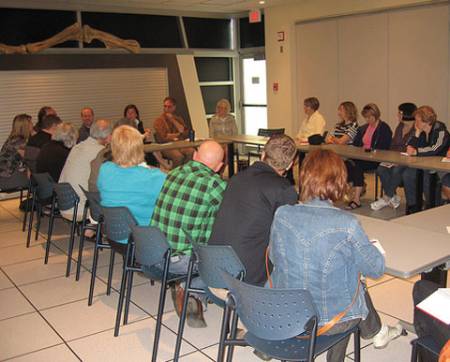
What would a town like Morden, Manitoba, with a population of just over 6,500, want to learn from Drumheller?
Well, they have a museum, the Canadian Fossil Discovery Centre (CFDC) that has big plans: to build a state of the art facility, comparable to the Tyrrell Museum.
Early in June, the town received a visit from a delegation from Manitoba travelling the region on a “best practice mission”.
So what did they learn from their visit?
“The recurring theme that came up at every location we stopped at was the power of partnership and how it is essential to be working together with those around you,” said Tyler Schroeder, general manager of CFDC.
A year ago, the CFDC, along with the regional tourism partner, the Pembina Valley Travel Association, approached Travel Manitoba to get help with their new project.
“We said to them, ‘we have a lot to learn, why don’t we go and learn from the best?’ and that was to go to Drumheller, learn how the Tyrrell Museum built their product, learn how the region has developed around the Tyrrell, and learn about all the intricacies and partnership and all the strategies that have come into play to turn southern Alberta into a major tourism destination.”
Travel Manitoba agreed to help, through their best practices mission, and opened the opportunity up to the province.
The focus of the mission was called destination development, and 31 people signed up.
The delegation visited Rosebud, Drumheller, Fort Macleod, Lethbridge and Vulcan, meeting with leaders in tourism in each community, touring their identified highlights.
“The main factor for us to visit Drumheller is we house a collection of fossils that is the under water version of what the Tyrrell Museum have. A number of our fossils are on display there,” said Schroeder.
The museum being a hub in the area, Schroeder said the group was impressed to see how the town had developed the dinosaur product, particularly with the creation of the World’s Largest Dinosaur as a way to drive tourism traffic through town.
“We recognized that in order for us to succeed we need our local business people to buy in to our product.”
“I think the best example of that was the attitude of the executive director at Tyrrell Museum, Andy Neuman, a friendly, engaging guy who was interested in working with those around him. He wasn’t working in isolation or in a vacuum or thinking that the Tyrrell was an island. He realized the necessity for integrating himself and the museum to the community around him.”
Back home, the Pembina Valley Travel Association is working on developing new tourism strategies as a result of the visit, which has re-invigorated their approach to tourism said Schroeder.
Meanwhile, he returned back to his museum with an unexpected bonus: an offer from the Tyrrell to help them in their big plan.
“One of the great things that we learned as a museum is that we can rely on the support of the Tyrrell Museum. They have offered their support to us as we pursue building a state of the art museum and we look forward to a long term relationship with them.”
He added although their museum will never be of the same size as the Tyrrell, it compliments the Tyrrell’s dinosaur collection, helping to paint an overall picture of what prehistoric life was like in this country.
Shroeder said a feasibility study suggested a $25 million building for their new museum.















